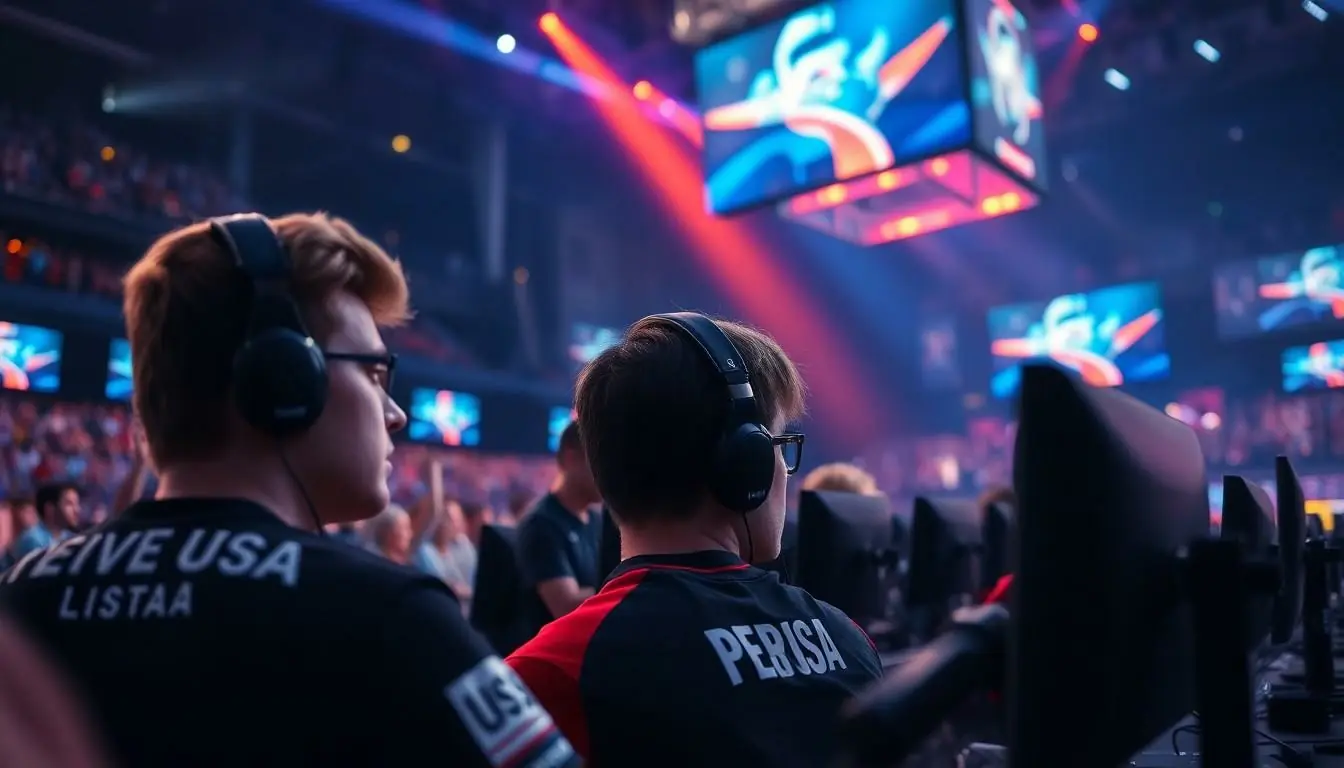In the fast-paced world of League of Legends esports, stats are the secret sauce that spices up every match. Picture this: a thrilling showdown between two teams, each player a master of their craft, and the stakes higher than a dragon’s lair. But how do fans and analysts keep track of who’s slaying it and who’s just slaying time? Enter the realm of esports stats—the treasure map to understanding player performance, team dynamics, and game-changing strategies.
Table of Contents
ToggleOverview of League of Legends Esports Stats
League of Legends esports stats play a crucial role in understanding the competitive scene. These statistics provide insights into player performance, team strategies, and match outcomes. Tracking metrics such as kill-death ratio, objectives secured, and gold earned reveals individual and team effectiveness.
Teams often analyze various data points, including win rates and champion select preferences, to refine their gameplay. Competitive seasons see a surge in data collection, capturing every match’s nuances. High-level tournaments showcase both players’ prowess and teams’ adaptability through detailed statistics.
Statistics influence fan engagement as well. Fans use performance data to gauge favorites or identify emerging talents. Platforms such as the League of Legends Championship Series (LCS) and League of Legends European Championship (LEC) provide extensive statistics. These metrics facilitate deeper conversations within the community and enhance the viewing experience.
Analysts rely on historical data to make predictions about future matches. Trends observed from previous seasons inform decisions on roster changes and drafting strategies. Data visualization tools enhance understanding by presenting complex information in simple formats.
In competitive play, situational statistics often highlight differences between victories and defeats. Assessments of objectives like towers taken or dragon kills sharpen team focus during matches. Reviewing esports stats leads to continuous improvement in gameplay and strategy execution.
Statistical analysis in League of Legends esports remains a dynamic landscape, reflecting the evolving nature of the game itself. Teams and analysts must adapt to emerging trends, making comprehensive data evaluation an integral aspect of success.
Key Statistics in Competitive Play
Statistics play a pivotal role in League of Legends esports. They provide insight into the competitive landscape, enriching the understanding of player and team performance.
Player Performance Metrics
Kill-death ratios (K/D) serve as a primary indicator of individual impact. A K/D ratio above 2.0 often signifies a player’s dominance during matches. Objective control metrics, such as towers destroyed and dragons secured, highlight a player’s contribution to team success. Gold earned per minute acts as another vital metric, reflecting efficiency in resource acquisition. Players exhibiting consistent performance across these metrics tend to make significant impacts in high-stakes competitions.
Team Rankings and Win Rates
Team rankings rely heavily on win rates. A consistent win rate above 60% indicates a competitive edge relative to other teams. Tournament placements also affect overall rankings, as results in premier events often shift team standings dramatically. Strong communication and synergy contribute to achieving higher win rates, which correlates with successful strategies. Focusing on the specifics, teams analyze their objectives secured per game to enhance performance. These elements together create a dynamic picture of team capabilities throughout the season.
Historical Trends in League of Legends Esports
Statistics in League of Legends esports display significant historical trends, illustrating the evolution of player skills and team performance.
Evolution of Player Stats Over Seasons
Player statistics evolved substantially from early seasons to current gameplay. Metrics like kill-death ratios and gold per minute have shown marked improvement as players adapt to competitive strategies. The rise in objective control illustrates teams’ focus on securing key elements, enhancing their overall game impact. Analysis from recent seasons reveals that average kill-death ratios increased from 3.0 in Season 1 to 5.6 in Season 10. Increased champion diversity in player pools also reflects changing gameplay styles. Data-driven gameplay has consistently shaped individual performance, allowing players to elevate their skills and contributions.
Impact of Major Tournaments on Stats
Major tournaments significantly influence player performance statistics. High-stakes environments force teams to refine strategies, which leads to unique gameplay dynamics. Players often showcase exceptional kill-death ratios during events like the World Championship or MSI. Studies show that teams’ win rates in tournaments correlate with their overall regular-season performance, establishing a pattern of pressure-driven success. Tournaments like the LCS and LEC further highlight the importance of securing objectives, with teams showing a marked increase in dragon kills during finals. This impact illustrates how the competitive arena shapes statistics that define the League of Legends esports landscape.
Importance of Stats in Strategy Development
Statistics play a crucial role in shaping strategies within League of Legends esports. They enable teams to evaluate player performance and assess the effectiveness of various strategies. Metrics like kill-death ratios, objectives secured, and gold earned provide insights into both individual and team dynamics.
Performance data highlights key areas for improvement. Analyzing win rates reveals how teams stack up against opponents, while champion select preferences guide important decisions during drafts. During competitive seasons, teams focus heavily on data collection, refining their gameplay to gain an edge.
High-level tournaments further showcase the significance of detailed statistics. Exceptional gameplay often aligns with strong performance metrics, illustrating how teams adapt to their opponents’ strategies. Fans engage with statistical data to follow their favorite players and identify emerging talents, enhancing their overall viewing experience.
Offering extensive statistics, platforms like the LCS and LEC facilitate informed discussions within the community. Analysts utilize historical data to predict match outcomes, examining trends and past performances to influence roster changes and drafting strategies.
Situational statistics often differentiate successful teams from those that fall short. Tracking objectives achieved, such as towers taken or dragon kills, sharpens a team’s focus during matches. Continuous review of esports stats promotes ongoing enhancements in gameplay and strategy execution.
Teams that understand their performance metrics can leverage them for better decision-making. Maintaining a win rate above 60% often implies a competitive edge in tournaments. Effective communication and synergy between players contribute significantly to this success, along with analyzing objectives secured per game, solidifying overall performance.
Future Predictions for League of Legends Esports Stats
Statistics in League of Legends esports continue to evolve, providing insights that shape the competitive landscape. Upcoming seasons are likely to see a rise in data analytics, as teams increasingly rely on advanced metrics to refine their strategies. With the importance of win rates and champion select preferences, teams will analyze new players’ data for potential roster changes more than ever.
Player performance metrics, such as kill-death ratios and objective control, will become focal points in scouting efforts. Expectations indicate an average kill-death ratio surpassing 6.0 in future seasons, echoing the trend of consistent improvement observed over the last decade. Historical improvements showcase how players adapt to evolving game strategies, and this trend likely continues as the meta shifts.
Fans will gain access to more personalized statistics through enhanced platforms and broadcasts. Comparisons of individual performances will feature prominently, allowing the community to engage with rising stars more closely. Increased attention to situational statistics, like baron rotations and vision control, could influence live commentary during matches.
Expectations for future tournaments suggest an increased focus on adaptability in gameplay. As stakes rise, so will the importance of quantifiable data in decision-making processes. The emphasis on objective-based play is expected to intensify, particularly in high-pressure environments, which directly correlate with match outcomes.
Furthermore, the community will benefit from historical analyses that inform predictions for upcoming tournaments. Trends from previous seasons will guide analysts in developing forecasts, leading to heightened anticipation around major events. Analysts will focus on correlating in-game statistics with team performance to paint a clearer picture of likely outcomes.
Conclusion
The landscape of League of Legends esports is increasingly defined by the power of statistics. As teams and players harness data to refine their strategies and enhance performance, the competitive edge becomes sharper. Fans are more engaged than ever as they utilize stats to connect with their favorite teams and players.
Looking ahead the evolution of these statistics will only deepen the appreciation for the game. With advancements in data collection and analysis fans can expect a richer viewing experience and analysts will continue to shape narratives around player and team success. The future of League of Legends esports promises to be as thrilling as the statistics that drive it.

